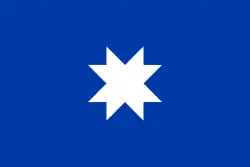Calfucurá
Calfucurá also known as Juan Calfucurá or Cufulcurá (b. late 1770s; d. 1873[1]), was a leading Mapuche lonco and military figure in Patagonia in the 19th century.[2] He crossed the Andes from Araucania to the Pampas around 1830 after a call from the governor of Buenos Aires, Juan Manuel de Rosas, to fight the Boroanos tribe. Calfucurá succeeded in ending the military power of the Boroanos when he massacred a large part of them in 1834 during a meeting for trade.
Calfucurá | |
|---|---|
| Born | late 1770s |
| Died | 4 June 1873 |
| Nationality | Mapuche |
| Title | Lonco |
| Successor | Manuel Namuncurá |
After the defeat of the Boroanos, Calfucurá settled in the Salinas Grandes area along with several other indigenous groups. He built a network of power that extended into the Araucanía Region as well as the southern frontier region of the Argentine Pampas, based on the strategic redistribution of goods, the development of kinship ties, and commercial relations. At the same time, he entered into diplomatic relations with both the State of Buenos Aires and the Argentine Confederation.[3]
In 1859 he attacked Bahía Blanca in Argentina with 3,000 warriors.
The decision of planning and executing the Conquest of the Desert was probably triggered by the 1872 assault of Calfucurá and his 6,000 followers on the cities of General Alvear, Veinticinco de Mayo and Nueve de Julio, where 300 criollos were killed, and 200,000 heads of cattle taken.
References
- Colin Mustful (2014). The Generation of 1837: Attitudes, Policies, and Actions Toward Indian Populations of Argentina. p. 62. ISBN 978-1-300-16918-5.
- George v Rauch (1999). Conflict in the Southern Cone: The Argentine Military and the Boundary Dispute with Chile, 1870-1902. Greenwood Publishing Group. pp. 36–37. ISBN 978-0-275-96347-7.
- De Jong, Ingrid; Ratto, Silvia (2008). "Redes políticas en el área arauco-pampeana: la Confederación indígena de Calfucurá (1830-1870)". Intersecciones de Antropología. 8: 241–260.
